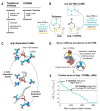Recent Progress Using De Novo Design to Study Protein Structure, Design and Binding Interactions
- PMID: 33802210
- PMCID: PMC7999464
- DOI: 10.3390/life11030225
Recent Progress Using De Novo Design to Study Protein Structure, Design and Binding Interactions
Abstract
De novo protein design is a powerful methodology used to study natural functions in an artificial-protein context. Since its inception, it has been used to reproduce a plethora of reactions and uncover biophysical principles that are often difficult to extract from direct studies of natural proteins. Natural proteins are capable of assuming a variety of different structures and subsequently binding ligands at impressively high levels of both specificity and affinity. Here, we will review recent examples of de novo design studies on binding reactions for small molecules, nucleic acids, and the formation of protein-protein interactions. We will then discuss some new structural advances in the field. Finally, we will discuss some advancements in computational modeling and design approaches and provide an overview of some modern algorithmic tools being used to design these proteins.
Keywords: binding; de novo protein design; protein-protein interactions.
Conflict of interest statement
The authors declare no conflict of interest.
Figures




Similar articles
-
An accurate binding interaction model in de novo computational protein design of interactions: if you build it, they will bind.J Struct Biol. 2014 Feb;185(2):136-46. doi: 10.1016/j.jsb.2013.03.012. Epub 2013 Apr 1. J Struct Biol. 2014. PMID: 23558036 Review.
-
Creation of artificial protein-protein interactions using α-helices as interfaces.Biophys Rev. 2018 Apr;10(2):411-420. doi: 10.1007/s12551-017-0352-9. Epub 2017 Dec 6. Biophys Rev. 2018. PMID: 29214605 Free PMC article. Review.
-
Recent advances in de novo design strategy for practical lead identification.Med Res Rev. 2003 Sep;23(5):606-32. doi: 10.1002/med.10046. Med Res Rev. 2003. PMID: 12789688 Review.
-
Computational approaches for de novo design and redesign of metal-binding sites on proteins.Biosci Rep. 2017 Mar 27;37(2):BSR20160179. doi: 10.1042/BSR20160179. Print 2017 Apr 28. Biosci Rep. 2017. PMID: 28167677 Free PMC article. Review.
-
Incorporating metals into de novo proteins.Curr Opin Chem Biol. 2013 Dec;17(6):934-9. doi: 10.1016/j.cbpa.2013.10.015. Epub 2013 Nov 1. Curr Opin Chem Biol. 2013. PMID: 24183813 Review.
Cited by
-
Role of Artificial Intelligence in Drug Discovery and Target Identification in Cancer.Curr Drug Deliv. 2024;21(6):870-886. doi: 10.2174/1567201821666230905090621. Curr Drug Deliv. 2024. PMID: 37670704 Review.
-
Computational Protein Design for COVID-19 Research and Emerging Therapeutics.ACS Cent Sci. 2023 Mar 20;9(4):602-613. doi: 10.1021/acscentsci.2c01513. eCollection 2023 Apr 26. ACS Cent Sci. 2023. PMID: 37122454 Free PMC article. Review.
-
Functional roles of enzyme dynamics in accelerating active site chemistry: Emerging techniques and changing concepts.Curr Opin Struct Biol. 2022 Aug;75:102434. doi: 10.1016/j.sbi.2022.102434. Epub 2022 Jul 21. Curr Opin Struct Biol. 2022. PMID: 35872562 Free PMC article. Review.
-
Protein Engineering in the Design of Protein-Protein Interactions: SARS-CoV-2 Inhibitors as a Test Case.Biochemistry. 2021 Nov 23;60(46):3429-3435. doi: 10.1021/acs.biochem.1c00356. Epub 2021 Jul 1. Biochemistry. 2021. PMID: 34196543 Free PMC article.
-
Tailorable Tetrahelical Bundles as a Toolkit for Redox Studies.J Phys Chem B. 2022 Oct 20;126(41):8177-8187. doi: 10.1021/acs.jpcb.2c05119. Epub 2022 Oct 11. J Phys Chem B. 2022. PMID: 36219580 Free PMC article.
References
Publication types
LinkOut - more resources
Full Text Sources
Other Literature Sources

